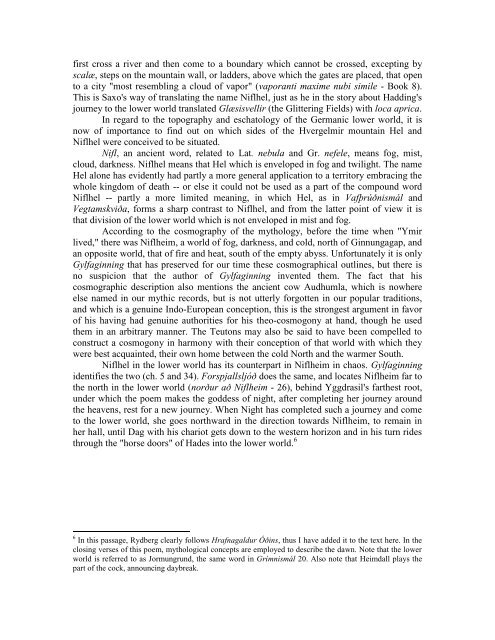Chapters 44-95 - Germanic Mythology
Chapters 44-95 - Germanic Mythology
Chapters 44-95 - Germanic Mythology
You also want an ePaper? Increase the reach of your titles
YUMPU automatically turns print PDFs into web optimized ePapers that Google loves.
first cross a river and then come to a boundary which cannot be crossed, excepting by<br />
scalæ, steps on the mountain wall, or ladders, above which the gates are placed, that open<br />
to a city "most resembling a cloud of vapor" (vaporanti maxime nubi simile - Book 8).<br />
This is Saxo's way of translating the name Niflhel, just as he in the story about Hadding's<br />
journey to the lower world translated Glæsisvellir (the Glittering Fields) with loca aprica.<br />
In regard to the topography and eschatology of the <strong>Germanic</strong> lower world, it is<br />
now of importance to find out on which sides of the Hvergelmir mountain Hel and<br />
Niflhel were conceived to be situated.<br />
Nifl, an ancient word, related to Lat. nebula and Gr. nefele, means fog, mist,<br />
cloud, darkness. Niflhel means that Hel which is enveloped in fog and twilight. The name<br />
Hel alone has evidently had partly a more general application to a territory embracing the<br />
whole kingdom of death -- or else it could not be used as a part of the compound word<br />
Niflhel -- partly a more limited meaning, in which Hel, as in Vafþrúðnismál and<br />
Vegtamskviða, forms a sharp contrast to Niflhel, and from the latter point of view it is<br />
that division of the lower world which is not enveloped in mist and fog.<br />
According to the cosmography of the mythology, before the time when "Ymir<br />
lived," there was Niflheim, a world of fog, darkness, and cold, north of Ginnungagap, and<br />
an opposite world, that of fire and heat, south of the empty abyss. Unfortunately it is only<br />
Gylfaginning that has preserved for our time these cosmographical outlines, but there is<br />
no suspicion that the author of Gylfaginning invented them. The fact that his<br />
cosmographic description also mentions the ancient cow Audhumla, which is nowhere<br />
else named in our mythic records, but is not utterly forgotten in our popular traditions,<br />
and which is a genuine Indo-European conception, this is the strongest argument in favor<br />
of his having had genuine authorities for his theo-cosmogony at hand, though he used<br />
them in an arbitrary manner. The Teutons may also be said to have been compelled to<br />
construct a cosmogony in harmony with their conception of that world with which they<br />
were best acquainted, their own home between the cold North and the warmer South.<br />
Niflhel in the lower world has its counterpart in Niflheim in chaos. Gylfaginning<br />
identifies the two (ch. 5 and 34). Forspjallsljóð does the same, and locates Niflheim far to<br />
the north in the lower world (norður að Niflheim - 26), behind Yggdrasil's farthest root,<br />
under which the poem makes the goddess of night, after completing her journey around<br />
the heavens, rest for a new journey. When Night has completed such a journey and come<br />
to the lower world, she goes northward in the direction towards Niflheim, to remain in<br />
her hall, until Dag with his chariot gets down to the western horizon and in his turn rides<br />
through the "horse doors" of Hades into the lower world. 6<br />
6 In this passage, Rydberg clearly follows Hrafnagaldur Óðins, thus I have added it to the text here. In the<br />
closing verses of this poem, mythological concepts are employed to describe the dawn. Note that the lower<br />
world is referred to as Jormungrund, the same word in Grímnismál 20. Also note that Heimdall plays the<br />
part of the cock, announcing daybreak.
















